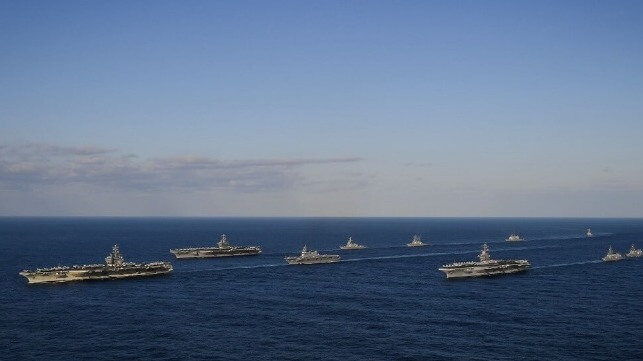U.S. Navy's Top Officer Renews Call for a 500-Ship Fleet

At a conference Friday, U.S. Navy Chief of Naval Operations Adm. Mike Gilday laid out a long-range for a much larger navy - not the 295 warships in today's fleet, but well over 500, including a mix of manned and unmanned platforms.
The number reflects recent thinking "about how we would fight differently, in distributed fashion across a wide vast ocean like the Pacific, in terms of integrating all domains simultaneously," Gilday said at the WEST 2022 defense conference in San Diego.
Gilday's office has concluded that an optimum force structure would include 12 carriers, as mandated by Congress; nine big deck amphibs; 20-30 smaller amphibs; 60 destroyers; 50 frigates; 70 attack subs; 12 nuclear ballistic missile submarines; and roughly 100 support ships. The balance would come from a future fleet of 150 unmanned vessels.
The proposal is the latest iteration of a series of back-to-back, start-and-stop Navy force structure review efforts conducted over the past several years. It is roughly similar to the Battle Force 2045 plan released by former Secretary of the Navy Mark Esper in October 2020, which called for a 500-ship fleet of comparable proportions. That plan was set aside when the Biden administration took office last year.

that matters most
Get the latest maritime news delivered to your inbox daily.
Gilday said that his office's new force structure proposal is based on an extensive series of exercises and trials, and it is "actually grounded on how we’re going to fight." The service has been working out the details of a decentralized, networked, dispersed operating concept called distributed maritime operations, which will spread assets across a broader area to make targeting harder for the adversary. It has also been pursuing conceptual development work on naval warfare with unmanned systems, and that work is under way at scale with the Navy's Unmanned Task Force and with a small-platform test unit at U.S. 5th Fleet, Task Force 59.
Any buildup will be dependent upon budget appropriations, which could prove a challenge. When adjusting for inflation, the Navy's top-line funding has not changed in a decade, according to Gilday, and finding the extra financing might require taking funds from the other armed services - a politically difficult proposal. Gilday has pointed out that the Navy had about 38 percent of the Pentagon's budget during the Cold War; that share has fallen to about 34 percent today.
